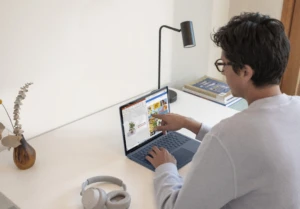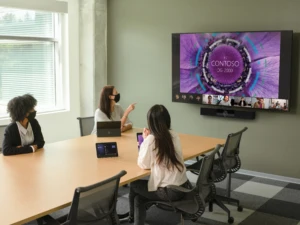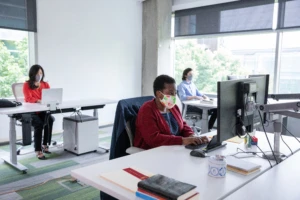
3 steps to build a successful hybrid working framework
The way we work has been turned on its head and will never be the same again. Last year, many of us quickly shifted to remote working. We’ve all had our own lessons and reflections, however perhaps the biggest is that remote work actually works. Leaders and organisations who were uneasy with the idea have come to appreciate business continuity in a very turbulent time. As we look ahead, instead of an en masse return to the office, we can expect the next great disrupter. Hybrid working. At Microsoft, we believe that combining the best of the digital workplace and the physical workplace is the future. The hybrid workplace is one which empowers people with the flexibility and autonomy of remote work, while enabling crucial human connection with colleagues and customers in the physical workplace.
To truly take charge in this intrepid new workplace, leaders need to take a step back, reflect on the lessons learnt and design for the future.
Let’s explore a framework and ideas for hybrid working.
To start, an effective hybrid workplace takes effort. You need a clear strategy – one that adapts to individual and organisational needs found both inside and outside the office. These decisions will impact everything from your culture, how you attract and retain talent, how you respond to change and how you innovate. Organisations will need to make sure strategy underpins experimentation. Don’t be afraid to roll out new initiatives or encourage creative ideas within your organisation. Use data and your employee’s own engagement to gauge success. Learn and correct as you go.
To build successful hybrid working, organisations need to think about three things: People, process and place. Underpinning these are empathetic and motivated leaders, and secure, inclusive technology powered by the cloud.
1. People

Your people are the heart of your business. And their wellbeing is critical. Over 70 percent of employees want flexible remote working to continue, while over 65 percent crave more in-person time with their teams. Hybrid working requires leaders to ensure employees have the flexibility to work when and where they want.
A successful hybrid organisation embeds empathetic leadership and prioritises individual wellbeing to help people focus and be their best. Almost half of the global workforce is likely to consider leaving their current employer this year. This means to stay competitive you need to take a people-first approach to your hybrid working strategy. At Microsoft, we’ve taken this approach, building wellbeing into our daily priorities, including implementing Wellbeing Days – additional paid time off for employees to focus on themselves.
The NHS took this approach when building its partnership with Microsoft. GPs, consultants, nurses, therapists, paramedics and support staff now have the digital tools to help them collaborate more effectively and access the information they need, when they need it.
“Adopting the most up to date digital tools and operating systems are crucial for a modern day NHS – allowing staff to work as efficiently as possible which will deliver even better care for patients.”
Matt Hancock, Secretary of State
A major benefit to hybrid working is the growth you’ll see in your talent pool. Because job roles are no longer required to be near the office, you’ll attract more diverse talent. And with secure digital tools that improve accessibility, productivity and anywhere collaboration you will drive a more inclusive workplace.
Building digital skills
And speaking of skills, underpinning the hybrid workplace is technology. Cloud-enabled devices and intelligent apps that support operations, collaboration, and productivity all require digital knowledge. Our research found that 63 percent of UK employees said they don’t have the digital skills needed to fulfil these roles. You can help start your employee’s learning paths on Microsoft Learn, and take advantage of on-demand training and events.
Building your employee’s skills is essential. To keep your organisation competitive and innovative. To help your employees learn, reinvent and grow. And ultimately, to help our nation’s economy. This isn’t a one off. You need to implement an always–on culture of learning. This will help support employees and drive innovation.
2. Process
 According to Accenture, organisations are focussing on digital transformation to the sum of $1.2 trillion globally, but are neglecting culture change. While technology can empower the hybrid working culture, it cannot create it. It needs to be a whole organisational shift. Leaders need to come together to unlock the data, expertise, and knowledge of the organisation.
According to Accenture, organisations are focussing on digital transformation to the sum of $1.2 trillion globally, but are neglecting culture change. While technology can empower the hybrid working culture, it cannot create it. It needs to be a whole organisational shift. Leaders need to come together to unlock the data, expertise, and knowledge of the organisation.
Equip employees with both digital skills and secure low/no code enterprise app technology to give them the autonomy to solve challenges and reimagine traditional processes. When you automate processes and workflows, you can innovate manual work, reduce errors and discover new insights to improve services.
We’ve partnered with Refinitiv to help financial firms connect, collaborate and unlock the power of their data. By doing this, organisations can make critical business decisions faster and gain new insights into their markets and customers, helping critical business decisions.
“When you add tools within that collaboration platform to help people surface information quickly, you create a seamless experience that brings the best of technology and data together with the human expertise needed to move markets forward.”
Ben Shepherd, Chief Strategy and Innovation Officer at Refinitiv
Make sure you provide policies and technology that support synchronous collaboration – meetings, voice and video calls – as well as asynchronous collaboration – where team members can dip in and out of projects and work when they have the time. Lean on your collaboration platform to build variety and encourage connectivity anywhere. For example, encourage non-work related check-ins, voice-only walking calls to prevent screen fatigue, or even buddy up colleagues from different teams for informal chats.
Leaders will need to embed a process of continuous testing, observing, and adjusting to processes to ensure they grow with your organisation and adapt to your employee’s needs.
3. Place
 Now we’re planning a hybrid workforce, office space is no longer limited to the office.
Now we’re planning a hybrid workforce, office space is no longer limited to the office.
Leaders must balance virtual and physical workplace to ensure equality and inclusion for everyone. To do this effectively, we need to restructure the physical workspace and invest in digital tools.
Humans are social creatures. Everyone – from those working at home, in the office or on the frontline – needs to be able to have a voice and feel included in your culture. Cloud-enable AV solutions such as Teams Rooms and interactive screens such as the Surface Hub 2S placed in meeting and social spaces can enhance collaboration and inclusivity.
However, it’s equally important that offices don’t become event venues. Your space must reflect the changing nature of the hybrid workplace, with the flexibility to adjust the physical environment for different scenarios, for example, collaboration spaces and focus areas.
Nationwide is integrating technology into their London new digital hub. Their ambition is to ensure Microsoft Teams is in every meeting room to ensure colleagues can join physical meeting rooms remotely, supporting greater collaboration and efficiency.
“The workplace of the future will be about choice, with the flexibility to be where we need to be to do our jobs as effectively as possible. Technology is essential as it provides the infrastructure needed so we can work dynamically.”
Patrick Eltridge, Chief Operating Officer at Nationwide
Use data to improve hybrid working flows
 At Microsoft, we are surveying employees and looking at data such as social graphs and employee traffic patterns. This helps us provide the right spaces for teams, while understanding how those needs evolve over time. 42 percent of employees say they lack essential office supplies at home. Therefore, it’s important to ensure you equip your employees with the right tools both at home and in the office. Microsoft Graph enables you to pool data across Microsoft 365 to inform business intelligence. This can boost user productivity, creativity, and team collaboration, while protecting business resources and users’ data from anywhere.
At Microsoft, we are surveying employees and looking at data such as social graphs and employee traffic patterns. This helps us provide the right spaces for teams, while understanding how those needs evolve over time. 42 percent of employees say they lack essential office supplies at home. Therefore, it’s important to ensure you equip your employees with the right tools both at home and in the office. Microsoft Graph enables you to pool data across Microsoft 365 to inform business intelligence. This can boost user productivity, creativity, and team collaboration, while protecting business resources and users’ data from anywhere.
Leaders need to set the tone for hybrid working. The strategy and plan to embed collaboration, creativity and culture into the hybrid workplace must come from the top. You need to ensure you look after your own wellbeing, taking regular days out of the office and logging offline when the day ends. This will help avoid the rise of presenteeism at the workplace or online.
Building sustainable growth with hybrid working
We are no longer bound to traditional notions of working. Our hybrid working framework lets us set aside our assumptions and start building a more flexible, people-focussed approach.
We believe this is an opportunity to progress. To drive sustainable growth and foster an accessible, innovative, and supportive culture. One where everyone is inspired, and no one is left behind.
Find out more
Discover how to help your organisation be more agile and resilient
Create an agile and innovative workplace
About the author
 Nick leads the Modern Work and Security business for Microsoft UK and has a passion for helping individuals and organisations to become more productive. Personal and organisational productivity is high on the list for every leader right now; Nick and his team dedicate their working hours to the role that Microsoft technologies can play as part of a business transformation journey.
Nick leads the Modern Work and Security business for Microsoft UK and has a passion for helping individuals and organisations to become more productive. Personal and organisational productivity is high on the list for every leader right now; Nick and his team dedicate their working hours to the role that Microsoft technologies can play as part of a business transformation journey.




